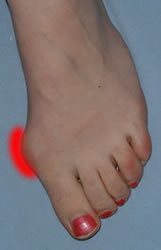How To Prevent Bunions On The Foot
Overview
 The classic bunion is a bump on the side of the great toe joint. This bump represents an actual deviation of the 1st metatarsal. In addition, there is also deviation of the great toe toward the second toe. In severe cases, the great toe can either lie above or below the second toe.
The classic bunion is a bump on the side of the great toe joint. This bump represents an actual deviation of the 1st metatarsal. In addition, there is also deviation of the great toe toward the second toe. In severe cases, the great toe can either lie above or below the second toe.
Causes
Bunions are a result of complex biomechanical changes that occur in your feet. The type of footwear that you wear does cause bunions. We know that foot bunions occur in about 30% of the population of most Western countries but only 3% in Eastern countries. They are seen most commonly in women and become more common as people get older. Tight-fitting shoes are thought to be the main cause of bunions.. Shoes such as high heels and shoes with tight toe boxes (eg womens fashion shoes and cowboy boots) are particularly damaging to the toes. These shoes have a sloping foot bed and a narrow toe box. The slope causes the front of the foot to bear your weight, which encourages your forefoot to widen. Also, the angle pushes your toes into the narrow toe box, causing the toes to become angled and squeezed together.
Symptoms
Signs and symptoms of a bunion include the base of the big toe is swollen and sticks out. The big toe is often bent towards the other toes, and sometimes the second toe is pushed to overlap the third toe. Skin around the big toe joint is red and sore. Thickened skin at the base of the big toe. Pain in the big toe or foot. Wearing shoes is painful. Pain or difficulty when walking.
Diagnosis
Although bunions are usually obvious from the pain and unusual shape of the toe, further investigation is often advisable. Your doctor will usually send you for X-rays to determine the extent of the deformity. Blood tests may be advised to see if some type of arthritis could be causing the pain. Based on this evaluation, your doctor can determine whether you need orthopaedic shoes, medication, surgery or other treatment.
Non Surgical Treatment
Bunions are progressive problems, meaning they tend to get worse over time. Sometimes severe-looking bunions don't hurt much, and sometimes relatively modest-looking bunions hurt a great deal. Thus, treatment varies depending upon a patient's symptoms. You can often improve the discomfort of bump pain by a change to more proper shoes. Alternatively, alterations to existing shoes may improve pain associated with bunions. Accommodative padding, shields and various over-the-counter and custom-made orthopaedic appliances can also alleviate bunion pain. Anti-inflammatory medications, steroid injections, physiotherapy, massage, stretching, acupuncture and other conservative treatment options may be recommended by your podiatric physician to calm down an acutely painful bunion. Long term, orthoses (orthotics) can address many of the mechanical causes of a bunion. Thus, while orthoses don't actually correct a bunion deformity, if properly designed and made, they can slow the progression of bunions. They can also be made to redistribute weight away from pain in the ball of the foot, which often accompanies bunion development. Padding, latex moulds and other accommodative devices may also be effective. While they don't correct the misalignment in the bones, they may alleviate pain. Often, though, when conservative measures fail to alleviate pain associated with the bunion, when you start to limit the types of activities you perform, when it's difficult to find comfortable shoes, and when arthritis changes how you walk, surgery may be the best alternative. 
Surgical Treatment
When early treatments fail or the bunion progresses past the threshold for such options, podiatric surgery may become necessary to relieve pressure and repair the toe joint. Several surgical procedures are available to the podiatrist. The surgery will remove the bony enlargement, restore the normal alignment of the toe joint, and relieve pain. A simple bunionectomy, in which only the bony prominence is removed, may be used for the less severe deformity. Severe bunions may require a more involved procedure, which includes cutting the bone and realigning the joint. Recuperation takes time, and swelling and some discomfort are common for several weeks following surgery. Pain, however, is easily managed with medications prescribed by your podiatrist.
Prevention
If these exercises cause pain, don't overdo them. Go as far as you can without causing pain that persists. This first exercise should not cause pain, but is great for stimulating blood and lymphatic circulation. Do it as often as you can every day. Only do this exercise after confirming it is OK with your doctor. Lie on your back and lift up your legs above you. Wiggle your toes and feet. Eventually you may be able to rapidly shake your feet for a minute at a time. Use your fingers to pull your big toe into proper alignment. Stretch your big toe and the rest of your toes. Curl them under for 10 seconds, then relax and let them point straight ahead for 10 seconds. Repeat several times. Do this at least once a day, and preferably several times. Flex your toes by pressing them against the floor or a wall until they are bent back. Hold them for 10 seconds, then release. Repeat several times. Grip with your toes. Practice picking up an article of clothing with your toes, dropping it, and then picking it up again. Warm water. Soak your feet for 20 minutes in a bowl of warm water. Try doing the foot exercises while soaking, and also relax and rest your feet. Epsom salts. Add it to your warm foot bath soak.